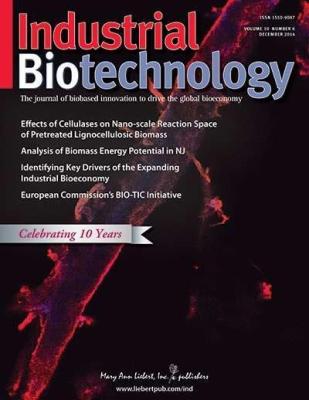Dec 19 2014
Pretreatment of cellulosic biomass using cell wall degrading enzymes is a critical step in the release of sugars needed to produce biofuels and renewable, biobased chemicals and materials.
 Industrial Biotechnology, led by co-editors-in-chief Larry Walker, Ph.D., Biological and Environmental Engineering Department, Cornell University, Ithaca, N.Y., and Glenn Nedwin, Ph.D., Mo.T., CEO and President, Taxon Biosciences, Tiburon, Calif., is an authoritative journal focused on biobased industrial and environmental products and processes, published bimonthly online with Open Access options and print. Credit: ©Mary Ann Liebert, Inc., publishers
Industrial Biotechnology, led by co-editors-in-chief Larry Walker, Ph.D., Biological and Environmental Engineering Department, Cornell University, Ithaca, N.Y., and Glenn Nedwin, Ph.D., Mo.T., CEO and President, Taxon Biosciences, Tiburon, Calif., is an authoritative journal focused on biobased industrial and environmental products and processes, published bimonthly online with Open Access options and print. Credit: ©Mary Ann Liebert, Inc., publishers
A new study that demonstrates and quantifies the impact of enzymatic hydrolysis and drying on the nanostructure and available reaction volume of pretreated hardwoods and switchgrass is published in Industrial Biotechnology, a peer-reviewed journal from Mary Ann Liebert, Inc., publishers. The article is available on the Industrial Biotechnology website until January 18, 2015.
In the article "Cellulases Significantly Alter the Nano-Scale Reaction Space for Pretreated Lignocellulosic Biomass," Dong Yang, Jean-Yves Parlange, and Larry P. Walker Cornell University, Ithaca, NY, measured sugar yield and the accessible reaction space, or pore volume, of mixed hardwoods and switchgrass biomass treated with a mixture of cell wall degrading enzymes. Enzymatic pretreatment resulted in a substantial reduction in pore volume for both types of biomass. Drying of pretreated, enzymatically hydrolyzed biomass led to a decrease in accessible pore volume of as much as 80%, suggesting irreversible pore collapse.
In many respects, the work results in this paper, and in other recent publications, reflect the belief that physical/structural features of biomass are extremely important in defining the rate and extent of hydrolysis.
"One of the key steps in lignocellulosic hydrolysis is speeding up the rate and the extent of the hydrolysis reaction," says Co-Editor-in-Chief Glenn Nedwin, PhD, MoT, CEO and President, Taxon Biosciences. "Access to an understanding of the physical and structural features of biomass are critically important. This paper by Yang et al., offers new insights into this bioconversion process."